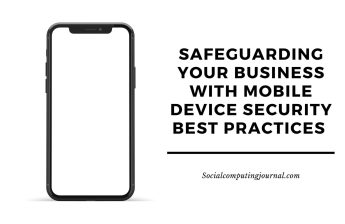Today, mobile devices have become indispensable tools for enhancing productivity. However, despite their widespread adoption, many organizations struggle with significant mobile productivity gaps, such as the discrepancies between the potential efficiency gains and the actual output achieved. These gaps can stem from poor device management, security vulnerabilities, or inefficient workflows, all of which contribute to lost time and revenue. Addressing these challenges requires a strategic approach to streamline operations and maximize return on investment.
Read on to learn about mobile productivity gaps, their costs, and solutions.
Understanding Mobile Productivity Gaps
Mobile productivity gaps occur when businesses fail to fully leverage their mobile infrastructure. Some common causes include:
Outdated Technology: Older devices or unsupported software tools can slow down operations.
Security Risks: Unsecured devices can lead to downtime due to breaches or malware.
Poor Connectivity: Inconsistent network access can disrupt workflows.
Lack of Standardization: Disparate devices and mobile apps can create compatibility issues.
These inefficiencies can result in substantial financial losses. For example, employees wasting just 30 minutes daily of work hours due to technical issues can cost a mid-sized company thousands of dollars per year in lost workplace productivity. This is where mobile device fleet management enters the picture. By adopting practices for structured mobile device fleet management, businesses can address these gaps and ensure a more effective mobile workforce.
Contents
The Hidden Costs of Inefficient Mobile Operations
Inefficient mobile operations can result in hidden expenses. These include:
1. Decreased Employee Output
When mobile devices underperform, employees waste valuable time resolving technical issues rather than focusing on core tasks. Slow load times, frequent app crashes, and synchronization failures can disrupt workflows, leading to frustration and reduced employee productivity. Over time, these inefficiencies can also accumulate, significantly lowering overall output and delaying critical business processes. These can ultimately affect revenue and operational efficiency.
2. Increased IT Support Burden
Unmanaged mobile devices can create a constant demand for IT support, forcing teams to address issues reactively rather than proactively. This reactive approach can consume valuable IT resources that could otherwise be allocated to strategic projects. Implementing mobile device fleet management can reduce disruptions by enabling centralized updates, security enforcement, and remote troubleshooting, minimizing downtime and support costs.
3. Security Breaches and Compliance Penalties
Unsecured mobile devices can expose businesses to cyber threats, including malware, phishing, and unauthorized data access, including business and financial information. A single breach can result in hefty regulatory fines, legal repercussions, and reputational damage. Furthermore, customers and partners will lose trust when sensitive business and personal data is compromised, making robust security measures, such as encryption, remote wipe capabilities, and strict access controls, essential for compliance of certain legal obligations and data protection laws, and risk mitigation.
4. Higher Operational Expenses
Poorly managed mobile fleets can lead to unnecessary costs, including redundant software licenses, inflated data plans, and underutilized devices. Without a unified mobile device strategy, businesses can overspend on overlapping apps, inefficient data usage, and outdated hardware. Optimizing mobile operations through standardization, usage monitoring, and lifecycle management can reduce waste and ensure cost-effective technology investments.
Solutions to Bridge Mobile Productivity Gaps

Closing mobile productivity gaps requires strategic solutions. These steps can help minimize downtime, reduce costs, and maximize efficiency, turning mobile devices into true productivity drivers rather than operational bottlenecks.
Below are some solutions to bridge mobile productivity gaps:
1. Implement Comprehensive Device Management
A robust mobile device management (MDM) system can provide IT teams with real-time visibility and control over all enterprise devices. Remote monitoring allows for instant troubleshooting, while automated updates can ensure all devices run the latest secure software versions. This centralized approach can help eliminate manual tracking, enforce uniform security policies, and significantly reduce IT workload while maintaining optimal device performance across the organization.
2. Standardize Hardware and Software
Deploying standardized device models and approved business applications across the workforce can eliminate compatibility headaches and create a seamless user experience. This uniformity reduces onboarding time for new employees and allows IT to focus on supporting a single ecosystem rather than multiple configurations. Scheduled hardware refresh cycles can maintain performance standards while phased software updates prevent disruptive transitions.
3. Enhance Security Protocols
Layered security measures as part of a strong data privacy framework can create multiple barriers against potential breaches. Mandatory multi-factor authentication verifies user identities, while end-to-end encryption safeguards data in transit. Remote wipe functionality acts as a last line of defense for lost devices. Additionally, proactive vulnerability scanning and penetration testing stay ahead of emerging threats, ensuring compliance with industry regulations and protecting sensitive corporate records, including contact information.
4. Optimize Connectivity Solutions
Reliable connectivity forms the backbone of mobile productivity. Enterprises should negotiate corporate data plans with multiple carriers for redundancy and implement enterprise-grade Wi-Fi with seamless roaming capabilities. Cloud-based SD-WAN solutions can dynamically route traffic for optimal performance, while always-on VPN connections can maintain secure access regardless of employee location or network conditions.
5. Train Employees on Best Practices
Targeted training programs can transform employees from security risks to proactive defenders. Interactive sessions should demonstrate proper device handling, secure authentication methods, and approved app usage. Regular phishing simulations and security refreshers can maintain awareness, while clear escalation paths for technical issues can prevent productivity loss from self-troubleshooting attempts. Knowledgeable users also become the first line of defense against mobile threats.
Conclusion
Mobile productivity gaps can pose significant financial and operational risks but are not insurmountable. By keeping the information mentioned above in mind, organizations can unlock the full potential of their office mobile workforce. Proactive measures can help reduce costs and enhance agility, ensuring businesses remain competitive in an increasingly mobile-driven world. Investing in the right tools and strategies today will yield long-term efficiency gains, transforming mobile devices from potential liabilities into powerful productivity enablers.







